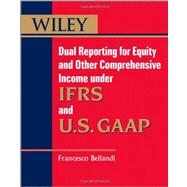
What is included with this book?
Francesco Bellandi holds a Degree in Economics (summa cum laude), LUISS University; M.B.A., SDA Bocconi School of Business, Bocconi University; Diploma in International Financial Reporting from the ACCA (The Association Of Chartered Certified Accountants, UK); and the Diploma in Private Equity from the A.I.F.I. (Italy’s private equity association).
Francesco Bellandi, U.S. CPA (Certified Public Accountant) and Dottore Commercialista (Italian Chartered Accountant), is a practitioner in U.S. GAAP/IFRSs dual reporting. He is a member of the AICPA, the NYSSCPA (New York State Society of Certified Public Accountants), and the NYSSCPA’s International Accounting & Auditing Committee.
He has served as a Board Director and Chief Financial Officer in Cobalt Waterline Group (2007–2008); Director Finance & Administration in Alitalia Maintenance Systems (Alitalia – Lufthansa Technik) (2003–2005); Chief Financial Officer in Alitalia North America & Mexico, NewYork (2001–2003); Director Business Planning&Finance Performance SEMEA Southern Europe, Middle East, and Africa in Société Internationale de Télécommunications A´eronautiques (1999–2001); Manager Finance & Administration/Shared Services, Reengineering & Restructuring in Ernst & Young (1997–1998); Financial Controller and Logistics Manager in Ericsson (1993–1997); Financial Analyst in IRI (Istituto per la Ricostruzione Industriale) (1988–1992).
Francesco Bellandi also holds executive seminars for CFOs on U.S. GAAP/IFRSs dual reporting. He can be reached at francesco_bellandi@yahoo.com or dualgaap.com, the website dedicated to U.S. GAAP/IFRSs Dual Reporting.
Preface xix
About the Author xxi
1 Introduction and Scope of Book 1
1.1 Nature of Accounting Literature and Pertinent Pronouncements 1
1.2 Perspectives and Major Implications of the Concept of Equity 1
1.3 The Concept of Other Comprehensive Income 3
1.4 The Financial Statement Presentation Project 3
1.5 Main Interrelationships with Other Projects 8
1.6 Significance of Equity 9
1.7 Scope of Book 10
2 Views on Equity and Implications 17
2.1 Terminology and Definitions of Terms 17
2.2 Basic Characteristics of Equity 39
2.3 Major Implications for Companies 47
3 Reserves 63
3.1 Terminology and Definitions of Terms 63
3.2 Reconciliation 65
3.3 Types of Reserves 67
3.4 Tracking of Equity 69
3.5 Function of Reserves 69
3.6 IFRS Implementation in Some Jurisdictions 78
3.7 Conservatism, True-and-Fair View, and Investors' Protection 88
3.8 Perspectives and Alternative Models 90
4 Equity Section of the Statement of Financial Position 93
4.1 Terminology and Definition of Terms 93
4.2 Single- Versus Multi-Step Equity Section 98
4.3 Noncontrolling Interest 99
4.4 Other Classifications in Temporary Equity 110
4.5 Layout of the Equity Section of the Statement of Financial Position 118
4.6 Capital Disclosures 124
4.7 Equity of Partnerships and Similar Entities 127
4.8 Net Assets of Entities with No Contributed Equity or with Owners' Interest that has Characteristics of Equity and Liabilities 128
4.9 Discount on Issuance 131
4.10 Increasing Rate Preferred Stock 132
4.11 Equity Issuance Costs 133
4.12 Subscriptions Receivable 136
4.13 Shares Issued in Exchange for a Note Receivable 137
4.14 Treasury Stock 139
5 Additional Paid-In Capital 155
5.1 Terminology 155
5.2 Additional Paid-In Capital Versus Other Paid-In Capital Accounts 155
5.3 Presentation of Additional Paid-in Capital 169
5.4 The Capital Surplus Model 170
6 Retained Earnings 173
6.1 Terminology and Definitions of Terms 173
6.2 Basic Principle of Retained Earnings 176
6.3 Categorization of Items that may Affect Retained Earnings 176
6.4 Items that may Directly Affect the Beginning Balance of Retained Earnings 177
6.5 Items that may Affect the Ending Balance of Retained Earnings 221
6.6 Direct Transfer to/from Retained Earnings without Passing through Profit or Loss 226
6.7 Income Tax Relating to Transactions that Directly Affect Retained Earnings 229
6.8 Presentation and Disclosure of Retained Earnings 229
6.9 Dividends 237
6.10 Towards a Theory of Retained Earnings 239
7 Other Comprehensive Income 241
7.1 Terminology 241
7.2 Definitions of Terms 244
7.3 The All-inclusive or Clean-Surplus Concept of Income 247
7.4 Purpose of Reporting Income and its Components 250
7.5 Linkage to Theories of Performance 261
7.6 Linkage with Capital Maintenance Concepts 269
7.7 The Other Comprehensive Income Dilemma 276
7.8 Recycling 281
7.9 Reporting Comprehensive Income and Other Comprehensive Income 286
7.10 Foreign Currency Translation Adjustment 313
7.11 Certain Long-Term Items 325
7.12 Highly Inflationary Economies 329
7.13 Hedges of a Net Investment in Foreign Operations 333
7.14 Available-for-Sale Investments 337
7.15 Cash Flow Hedges 349
7.16 Revaluation Model 352
7.17 Consolidation, Deconsolidation, and Change in Interest in an Investment 360
7.18 Pension Accounting 367
7.19 Recent Developments for Financial Instruments 374
7.20 Shadow Accounting 377
7.21 Towards a Comprehensive Model of Equity and Other Comprehensive Income 377
8 Presentation of Taxes on Equity Items 381
8.1 Intraperiod Tax Allocation to Equity 381
8.2 Income Tax Recognized in Equity 385
Bibliography 419
Index 423
The New copy of this book will include any supplemental materials advertised. Please check the title of the book to determine if it should include any access cards, study guides, lab manuals, CDs, etc.
The Used, Rental and eBook copies of this book are not guaranteed to include any supplemental materials. Typically, only the book itself is included. This is true even if the title states it includes any access cards, study guides, lab manuals, CDs, etc.